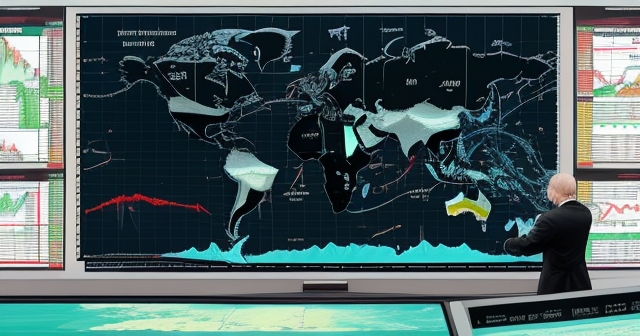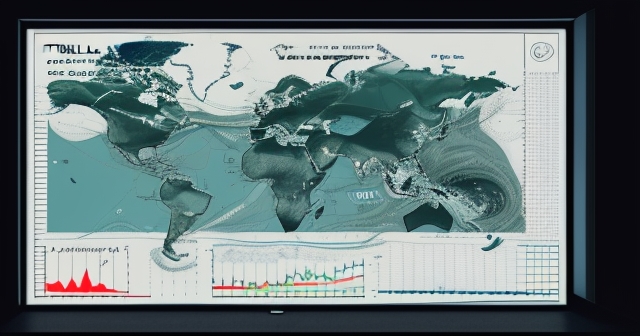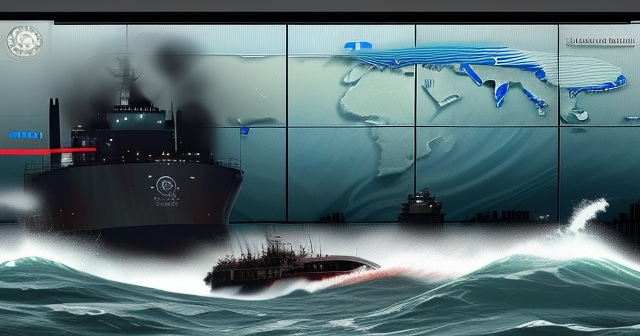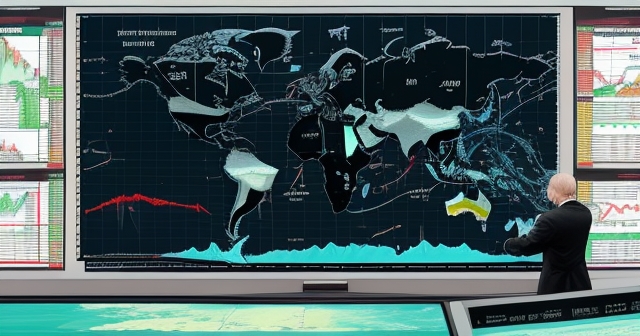WTI Crude’s Grueling Climb: Unpacking the Headwinds Facing $80 Per Barrel
Welcome, fellow navigators of the financial markets. Today, we turn our attention to a commodity that powers the global economy and often dictates the rhythm of broader financial sentiment: West Texas Intermediate, or WTI crude oil. Its price journey is rarely a smooth ascent; it’s more often a turbulent voyage influenced by a confluence of powerful forces. Recently, the $80 per barrel mark has emerged not just as a price point, but as a significant technical and psychological barrier for WTI futures. Why is breaking through this level proving to be such a challenge? What fundamental and technical factors are converging to create these headwinds? Let’s embark on a detailed exploration together, breaking down the complex interplay of global events, economic realities, technical signals, and investor psychology that currently governs the outlook for WTI crude.
Understanding the forces at play is crucial for any trader or investor looking to navigate the oil market. It’s not enough to simply watch the price chart; you need to comprehend the engines driving it. Think of the oil market as a vast ship, constantly buffeted by geopolitical winds, steered by economic currents, and needing precise navigation based on technical charts and the collective sentiment of its crew – the global investors and traders. Our goal here is to provide you with the knowledge, much like a seasoned captain’s charts and weather reports, to understand this journey, particularly as WTI approaches that critical $80 latitude.
- The $80 mark represents a crucial psychological barrier for traders.
- Various economic indicators impact oil prices and supply levels.
- Technical analysis aids in understanding resistance and support levels.

Geopolitical Pulses and Oil’s Nervous Response
The oil market is uniquely sensitive to geopolitical events. Even the hint of tension or a breakthrough in international relations can send ripples through prices. Consider recent history: periods of heightened tension in the Middle East, like the Iran-Israel conflict, naturally inject a risk premium into oil prices, particularly for Brent crude, which is more directly exposed to supply disruptions in the region. However, a de-escalation or, conversely, a positive development like a US-China trade truce, can have the opposite effect, offering temporary relief and price support.
We’ve seen this play out. A US-China trade truce, involving discussions around potential tariff rollbacks, provided a notable, albeit short-lived, boost to both WTI and Brent prices from lower levels. Remember when WTI rebounded from around the $55.40 mark? Geopolitical optimism was a key catalyst at that moment. However, these short-term bumps often run into more fundamental, underlying trends. It’s like catching a favourable gust of wind that helps for a while, but doesn’t change the overall direction dictated by larger currents.
Simultaneously, supply dynamics are always in focus. The actions and statements from OPEC and its allies (OPEC+) are paramount. While OPEC+ has demonstrated an ability to influence supply through production cuts, the market constantly anticipates their next move. For instance, expectations of an OPEC production increase potentially coming in May or June can weigh on sentiment, acting as a potential cap on price rallies. Combine this with the possibility of increased supply returning to the market from regions like Iran, perhaps linked to developments in US-Iran talks, and you create a delicate balance. Any perceived shift in this supply/demand equilibrium, even a potential future one, influences current trading decisions and makes breaking significant resistance levels like $80 that much harder.

Furthermore, Non-OPEC supply growth, particularly from countries like the United States, continues to act as a persistent counterbalance to OPEC+ efforts to tighten the market. Innovations in drilling technology and infrastructure, even amidst fluctuating rig counts, mean that supply resilience outside the cartel remains a significant factor, often dampening the bullish impact of supply side concerns and adding to the headwinds below targets like $80.
The Gravity of Macroeconomics: US Debt, Deficits, and Demand
Beyond the immediate supply-demand picture, the health of the global economy, and particularly major economies like the United States and China, exerts a powerful force on oil prices. Oil is the lifeblood of industrial activity and transportation, so economic growth translates directly into demand. But what happens when economic signals become murky, or worse, point towards a slowdown?
The United States faces significant macroeconomic challenges that cast a long shadow over the demand outlook. Consider the level of US federal debt. It sits at historically high levels, nearing 122% of GDP. While government spending can stimulate activity in the short term, high debt levels raise concerns about long-term fiscal sustainability and introduce risks like fiscal dominance – a scenario where monetary policy might be constrained by the need to service government debt. This complexity can stress the financial system, potentially leading to volatility in the dollar or requiring higher interest rates over time to attract investors to government bonds.
Couple high debt with significant fiscal deficits. Large deficits, while sometimes used to combat recessions, can contribute to inflation if not managed effectively. More importantly for oil demand, efforts to reduce these deficits could involve government spending cuts or tax increases, actions that can dampen economic activity. Some analyses suggest that a significant reduction in the fiscal deficit – say, a 3% reduction – could potentially lead to a 3% drop in GDP. A weaker economy directly impacts demand for fuel products like gasoline and diesel, limiting the upward potential for WTI crude prices, especially when they approach levels seen as historically high relative to current demand conditions.
| Economic Indicator | Impact on Oil Demand |
|---|---|
| US Federal Debt | Increases pressure on fiscal policy, potentially reducing spending |
| Fiscal Deficit | Can contribute to inflation, dampening overall economic activity |
| GDP Growth Rate | Directly correlates with oil demand; slowing growth can decrease demand |
These macroeconomic headwinds are fundamental. They represent structural challenges that can limit how high oil demand can realistically go in the medium to long term. Until there is a clear path towards sustainable, strong economic growth without the overhang of massive debt and deficit concerns, the demand side of the equation provides a significant anchor, making a sustained move above $80 a steeper climb.
Inflation, Interest Rates, and the Fed’s Tightrope Walk
Inflation has been a persistent challenge in many parts of the world, including the United States. When prices for goods and services rise significantly, central banks, like the Federal Reserve, typically respond by raising interest rates. The goal is to cool down the economy and bring inflation under control. However, this action carries its own risks.
Higher interest rates make borrowing more expensive for businesses and consumers. This can slow down investment, reduce consumer spending, and ultimately curb economic growth. The concept of “higher-for-longer” interest rates, where rates remain elevated for an extended period to ensure inflation is truly subdued, increases the likelihood of an economic slowdown or even a recession risk. As we discussed, a weakening economy translates to lower demand for energy.
Think about the impact: higher rates can lead to less manufacturing activity, reducing the need for industrial fuels. They can also affect consumer confidence and spending on things like travel, hitting demand for gasoline and jet fuel. While oil prices themselves contribute to inflation, the fight against inflation by monetary authorities can inadvertently put downward pressure on oil demand by slowing the economy down. This complex relationship means that even if geopolitical factors create short-term supply fears, the overriding concern about global economic health, driven by central bank actions aimed at controlling inflation, acts as another major headwind for oil prices pushing towards higher targets like $80.

The market is constantly weighing the risk of supply disruptions against the risk of demand destruction caused by economic contraction. Currently, for many market participants, the macroeconomic concerns related to inflation and the subsequent monetary policy response appear to outweigh some of the bullish supply narratives, contributing to the difficulty WTI faces in sustainably breaking through resistance levels.
Technical Analysis: Why $80 Acts as a Formidable Barrier
Now, let’s look at the charts. Technical analysis provides a different lens through which to view the market, focusing on price patterns, trends, and key levels derived from historical trading data. For WTI crude oil, the technical picture below the $80 mark has been notably challenging for bulls.
Since its peak in 2022, WTI has exhibited a persistent negative or bearish trend. This doesn’t mean the price only goes down; markets move in waves. But the overall direction, when viewed from a longer-term perspective, has been one of decline or consolidation at lower levels compared to those highs. This downward trajectory has established certain price points as significant barriers or “resistance” levels – prices where selling pressure tends to emerge, preventing further upward movement.
The $80 level has been identified as a critical resistance point. Why is this specific number so important? Resistance levels often coincide with previous highs, significant chart patterns, or psychological round numbers. In the case of WTI, $80 (or slightly above, around $80-$82) has historically represented points where rallies have faltered. Furthermore, technical patterns observed since the 2022 peak, such as the breakdown from structures resembling a descending triangle, reinforce the idea that the long-term trend remains bearish below certain thresholds, and $80 is a key one.
| Technical Level | Significance |
|---|---|
| $80.00 | Major resistance level hindering upward movement |
| $70.35 | Key support level, a potential buying opportunity |
| $65.00 | Strong psychological support zone |
Think of resistance as a ceiling. For the price to move higher, it needs to gather enough momentum – enough buying pressure – to break through this ceiling convincingly. For technical analysts, a sustained break above $80 is often cited as the necessary condition to potentially negate the prevailing bearish outlook and signal a possible shift towards a more bullish trend. As long as the price remains below $80, the technical picture reinforces the idea that the path of least resistance is sideways or even downwards, making every attempt to climb towards this level a battle against inherent selling pressure.
Supply Dynamics: OPEC’s Moves, Non-OPEC’s Rise, and Geopolitical Shocks
Let’s delve deeper into the supply side. While demand is influenced by macroeconomics, supply is a function of production decisions, geological realities, and geopolitical stability. As we noted earlier, OPEC+ plays a pivotal role. Their coordinated production cuts have been instrumental in attempting to support prices. However, maintaining compliance among diverse member nations can be challenging, and the market is always on edge about whether planned increases will materialise or if compliance will waver.
The expectation that OPEC+ might increase production in the coming months, potentially as early as May or June, introduces a supply factor that could absorb some of the potential demand growth or simply add barrels to a market already concerned about overall economic health. This expected increase acts as a potential ceiling on prices, making it harder for WTI to push significantly higher.
Compounding this is the resilience and growth of Non-OPEC supply. The United States, in particular, has demonstrated significant capability to increase production, especially from shale basins like the Permian in Texas and the Bakken in North Dakota, although growth rates can fluctuate based on price incentives and drilling activity (reflected in rig count data). Other non-OPEC producers like Canada, Brazil, and Guyana are also contributing to global supply increases. This structural growth in non-OPEC output means that even if OPEC+ maintains discipline, there are more barrels entering the market from elsewhere, providing a constant counterweight to price rallies.

Then there are the unpredictable geopolitical elements. While the containment of the immediate Iran-Israel conflict reduced a significant geopolitical risk premium that had temporarily boosted prices, other risks remain. The potential for unexpected supply disruptions in volatile regions or shifts in sanctions policy (e.g., related to Iran or Venezuela) are always on the market’s radar. These risks can cause sharp, short-term price spikes, but unless they result in prolonged, significant supply losses, their impact on the overall trend and the challenge posed by the $80 resistance level can be limited. The market has learned to distinguish between temporary scares and fundamental shifts in supply/demand.
Investor Sentiment: The Increasing Bearish Bet Below $80
Market prices are not just determined by fundamentals; they are also heavily influenced by the collective mood and positioning of investors and traders. This is where investor sentiment and positioning data become incredibly insightful. How are large players, like hedge funds and other money managers, betting on the future direction of WTI crude?
Recent data reveals a notable shift in positioning specifically related to WTI below the $80 mark. There has been an observed increase in bearish positioning, specifically through increased short selling of WTI futures contracts. This means money managers are placing bets that the price of WTI will fall or struggle to rise significantly from current levels.
For instance, reports have indicated significant selling activity by hedge funds in NYMEX/ICE WTI contracts. In one specific week, they reportedly sold the equivalent of 35 million barrels, a rate described as the fastest in 10 weeks. This aggressive short-selling activity underscores a lack of conviction in a sustained rally above $80 among this influential group of market participants. It suggests that below $80, the balance of power is shifting towards those who believe the path of least resistance is downwards or consolidating.
Interestingly, during some periods of geopolitical tension, while WTI saw increased shorting, there might have been a simultaneous increase in bullish exposure to Brent crude contracts, reflecting the localized nature of certain geopolitical risks to Middle Eastern supply. This highlights that positioning isn’t uniform across all oil benchmarks but reflects specific risk assessments. While the overall petroleum futures complex held a net bullish position (e.g., a 3.60:1 long-to-short ratio at one point), the conviction behind this bullishness was noted as being relatively weak (e.g., in the 42nd percentile since 2013), suggesting that while the market as a whole wasn’t overwhelmingly bearish on *all* oil, sentiment specifically around WTI’s ability to break higher above $80 was increasingly negative.
Expert Perspectives: Is the Market Too Bearish, or Just Realistic?
In the complex world of oil markets, differing opinions among experts are common. Some market observers look at the current technical and fundamental landscape and argue that the market has become “far too bearish.” They might point to factors like global oil inventories being relatively low compared to historical levels, the potential for OPEC+ to maintain discipline longer than expected, or the possibility that geopolitical risks, even if contained recently, still pose an underlying threat to supply.
These experts might forecast a more likely price range, perhaps between $70 and $80 per barrel, seeing the downside as limited by supply constraints and potential demand resilience, while acknowledging the significant resistance around $80. They might argue that calls for significantly higher prices, such as $85 or $90 per barrel in the near term, seem less probable given the prevailing macroeconomic climate and investor positioning below $80.
| Analyst | Perspective |
|---|---|
| Eric Nuttall | Market is “far too bearish”; potential for prices to rebound towards $80 |
| John Kemp | Significant resistance around $80; limited upside in short term |
| Market Consensus | Weight of macroeconomic concerns dominates current sentiment |
Ultimately, the market price is the collective outcome of all these differing views and the actions they drive. The current price below $80, despite some expert calls for it being too low, suggests that the weight of macroeconomic concerns, technical resistance, and bearish investor positioning below that level is currently dominating the narrative.
Key Support and Resistance Levels to Watch
For traders utilizing technical analysis, identifying key support and resistance levels is fundamental. These are price zones where buying (support) or selling (resistance) pressure is expected to be strong, potentially causing price reversals or consolidations. For WTI crude, several levels around the current trading range are particularly significant:
- Key Resistance Level: $80.00 – $82.00. As extensively discussed, this is the major barrier. A sustained close significantly above this zone would be a technically bullish signal, potentially targeting higher levels.
- Major Resistance Levels Above $80: Beyond $80, potential resistance areas lie around $86.35 and a stronger cluster between $90.79 – $91.10. These levels represent previous highs or significant technical points derived from larger chart patterns. Reaching these would require overcoming the initial $80 hurdle and sustained bullish momentum.
- Key Support Levels Below $80: Should WTI fail to break $80 and instead turn lower, several support levels could offer potential buying opportunities or areas where declines might pause. Significant support is noted around $70.35, and below that, strong psychological and technical support lies around $65.00. Further downside could test levels around $60.00, which represents a major long-term support zone.
Monitoring how price reacts at these specific levels provides crucial clues about market sentiment and potential future direction. A failure to break resistance reinforces the prevailing trend below that level, while a successful break suggests a potential shift in momentum. Similarly, holding above support indicates underlying buying interest, while breaking below suggests further downside risk. The battle around $80 is a test against a major resistance wall, and the outcome will be keenly watched by traders worldwide.
Domestic US Indicators: Clues for Future Demand
While global factors dominate the oil market, domestic data from major consumers like the United States offers vital insights into the health of demand. Recent US economic indicators have painted a picture of potential softening, which directly impacts fuel consumption.
Data points such as declining industrial production and lower manufacturing output signal reduced activity in factories, which are significant consumers of energy. This slowdown in industrial activity translates into lower forecasts for overall GDP growth. Furthermore, reports on consumer spending, like a decline in retail sales in the previous month, suggest that consumer demand might be weakening. Remember, consumer spending is a major driver of demand for gasoline and diesel through transportation and commercial activities.
Lower demand for finished fuel products ultimately filters back to the demand for crude oil. If refiners anticipate weaker sales of gasoline and diesel, they may reduce their crude purchases, or inventories of crude and products may build, both of which can weigh on WTI prices. These domestic economic indicators, therefore, act as real-time data points confirming the potential for macroeconomic headwinds to translate into tangible reductions in oil consumption, adding another layer to the challenges WTI faces in moving higher towards $80.

Keeping an eye on these specific data releases – industrial production, retail sales, GDP reports, even weekly inventory data (API and EIA) – can provide early clues about shifts in the demand landscape that are essential for forming a comprehensive market outlook. They offer a ground-level view that complements the broader macroeconomic picture.
Navigating the Complexity: Applying Analysis to Trading
Understanding the myriad factors influencing WTI crude oil prices – from geopolitics and macroeconomics to technical levels and investor sentiment – is the cornerstone of informed trading. This analysis isn’t just academic; it’s designed to help you make better decisions when participating in the market.
How can you apply this knowledge? Traders looking to act on this analysis might consider various instruments. WTI futures contracts, traded on exchanges like NYMEX, are the direct way to gain exposure to the price of crude oil. However, futures involve significant leverage and specific contract sizes and expiry dates.
Alternatively, many traders use derivatives like Contracts for Difference (CFDs) to speculate on the price movements of WTI crude oil. CFDs allow you to trade on the price difference of the underlying asset without owning the commodity itself. They often offer greater flexibility in position sizing and allow trading on margin.
As you analyze these factors and consider how you might want to participate in the oil market or explore other commodity and financial markets, you’ll need a reliable platform. If you’re considering starting your trading journey or exploring more CFD products across various asset classes, including commodities, indices, and forex, then Moneta Markets is a platform worth considering. It offers access to over 1000 financial instruments, catering to both novice and professional traders.
Using a platform that provides comprehensive tools and access to diverse markets is key. A good trading experience requires factors like high-speed execution, competitive spreads, and robust analytical tools. Choosing the right trading platform is a critical step in applying your market analysis effectively.
Remember, whether trading futures or CFDs, risk management is paramount. Leverage can amplify both gains and losses. Understanding the fundamental and technical forces at play helps you contextualize price movements, but having a clear trading plan, setting stop-losses, and managing your position size relative to your capital are essential practices for navigating volatile markets like oil.
Understanding complex dynamics like why WTI crude struggles at the $80 resistance is vital. It combines macro (economic health, fiscal policy), micro (supply, demand), and behavioural (sentiment, positioning) factors. Being able to translate this understanding into potential trading strategies, whether long or short, is the path towards potentially profitable engagement with the market. Exploring different trading products and platforms allows you to find the best fit for your strategy and risk tolerance.
Conclusion: The Combined Headwinds Facing WTI at $80
In concluding our journey through the current landscape for WTI crude oil, it’s clear that the path towards and above the $80 per barrel mark is currently obstructed by a powerful convergence of headwinds. The factors we’ve explored – from the nuanced supply/demand balance influenced by OPEC+ decisions and non-OPEC growth, to the heavy macroeconomic gravity exerted by US debt, deficits, and the fight against inflation, and finally to the persistent bearish technical signals and increasing negative investor sentiment specifically below $80 – are all working in concert.
Temporary lifts from geopolitical optimism or short-term supply jitters may occur, but they appear insufficient to overcome the more fundamental challenges. The technical resistance at $80 isn’t just a line on a chart; it represents a price where the market’s collective assessment of these underlying factors turns decisively negative, leading to increased selling pressure.
While some experts may argue that the market is leaning too bearishly, the concrete actions of money managers increasing their short bets on WTI below $80 underscore the prevailing sentiment: breaking this key resistance level presents a significant challenge in the current environment. The risks of a global economic slowdown, driven by persistent inflation and the monetary policy required to combat it, continue to weigh heavily on the demand outlook, providing a fundamental anchor for prices.
For investors and traders, navigating this market requires a holistic view, integrating insights from fundamental analysis, technical charts, and sentiment data. The $80 level serves as a critical benchmark. A sustained move above it would signal a potential shift in the balance of power, suggesting that the bullish forces have finally overcome these considerable headwinds. Until then, WTI’s journey towards $80 remains a battle against formidable forces, requiring careful monitoring and informed decision-making.
ratio of bullish to bearish sentiment on twitter for oil futures going to $80 per barrelFAQ
Q:What factors contribute to the bearish sentiment on WTI crude prices?
A:Factors include macroeconomic challenges, rising US debt, inflationary pressures, and technical resistance levels.
Q:How does geopolitical tension affect oil prices?
A:Geopolitical tensions can introduce risk premiums, causing price fluctuations, especially with OPEC’s response and production decisions.
Q:What indicators should traders watch for oil price movements?
A:Key indicators include US economic data, OPEC production levels, and investor positioning trends in WTI futures.
